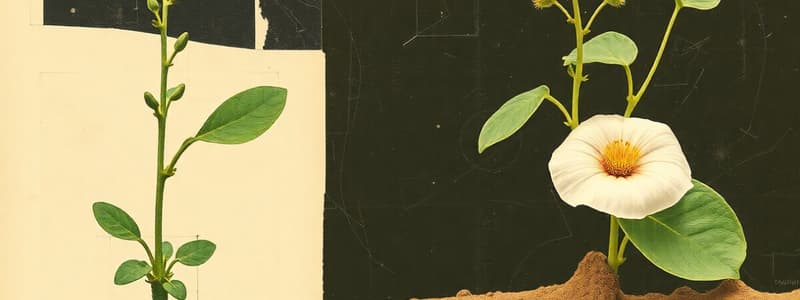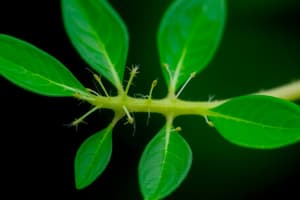Podcast
Questions and Answers
Which of the following processes primarily occurs during the phase of elongation in plant cell growth?
Which of the following processes primarily occurs during the phase of elongation in plant cell growth?
- Cells increase in size, contributing to tissue length. (correct)
- Cells divide rapidly through mitosis.
- Cells specialize into various types of tissues.
- Formation of lateral meristems along the stem.
What is the primary function of the apical meristem in plants?
What is the primary function of the apical meristem in plants?
- Producing new cells for lateral growth.
- Increasing root penetration into the soil.
- Increasing the plant's girth through secondary growth.
- Increasing the plant's length through primary growth. (correct)
In which phase of cell growth do cells undergo specialization to form complex tissues such as vascular bundles?
In which phase of cell growth do cells undergo specialization to form complex tissues such as vascular bundles?
- Phase of Elongation
- Phase of Penetration
- Phase of Division (Meristematic Phase)
- Phase of Differentiation (Maturation) (correct)
How does the lateral meristem contribute to plant growth?
How does the lateral meristem contribute to plant growth?
Which of the following is NOT a typical measurement used to assess plant growth characteristics?
Which of the following is NOT a typical measurement used to assess plant growth characteristics?
If a plant's root system is showing increased penetration in the soil, which phase of cell growth is primarily responsible?
If a plant's root system is showing increased penetration in the soil, which phase of cell growth is primarily responsible?
Which process primarily contributes to increasing the girth of a plant stem?
Which process primarily contributes to increasing the girth of a plant stem?
What cellular process is most active during the meristematic phase of cell growth?
What cellular process is most active during the meristematic phase of cell growth?
A plant's development is best described as:
A plant's development is best described as:
Which event marks the beginning of developmental characteristics in plants?
Which event marks the beginning of developmental characteristics in plants?
What would be the likely effect of a localized environmental stressor that inhibits lateral meristem activity?
What would be the likely effect of a localized environmental stressor that inhibits lateral meristem activity?
What is the primary distinction between primary and secondary growth in plants?
What is the primary distinction between primary and secondary growth in plants?
Which of the following processes is NOT a component of plant development?
Which of the following processes is NOT a component of plant development?
A researcher observes a plant with significantly reduced leaf area compared to others of its species. Which factors might the researcher investigate to explain this?
A researcher observes a plant with significantly reduced leaf area compared to others of its species. Which factors might the researcher investigate to explain this?
During seedling development, what is the plant primarily focused on?
During seedling development, what is the plant primarily focused on?
What triggers the initiation of seed germination?
What triggers the initiation of seed germination?
In adult plant formation, which event signifies the attainment of maturity?
In adult plant formation, which event signifies the attainment of maturity?
Which meristem is most active during seedling development?
Which meristem is most active during seedling development?
If a plant species lacks lateral meristems, what type of growth would it be incapable of?
If a plant species lacks lateral meristems, what type of growth would it be incapable of?
How do axillary buds contribute to the overall growth and form of a plant?
How do axillary buds contribute to the overall growth and form of a plant?
Flashcards
Plant Growth
Plant Growth
Irreversible and permanent increase in the size of a plant or its parts.
Plant Development
Plant Development
Sequence of qualitative structural changes in a plant's life, from seed to senescence.
Morphogenesis
Morphogenesis
The acquisition of specific forms and structures during plant development.
Differentiation (Plant Cells)
Differentiation (Plant Cells)
Signup and view all the flashcards
Primary Growth
Primary Growth
Signup and view all the flashcards
Secondary Growth
Secondary Growth
Signup and view all the flashcards
Apical Meristems
Apical Meristems
Signup and view all the flashcards
Lateral Meristems
Lateral Meristems
Signup and view all the flashcards
Seed Germination
Seed Germination
Signup and view all the flashcards
Adult Plant Formation
Adult Plant Formation
Signup and view all the flashcards
Phase of Division
Phase of Division
Signup and view all the flashcards
Phase of Elongation
Phase of Elongation
Signup and view all the flashcards
Phase of Differentiation
Phase of Differentiation
Signup and view all the flashcards
Growth Characteristics
Growth Characteristics
Signup and view all the flashcards
Development Characteristics
Development Characteristics
Signup and view all the flashcards
Germination
Germination
Signup and view all the flashcards
Seedling Emergence
Seedling Emergence
Signup and view all the flashcards
Meristems
Meristems
Signup and view all the flashcards
Study Notes
- Study notes are presented below
LU4.1: Growth and Development
- Growth is the permanent increase in a plant's size, considering cell size, tissue expansion, and overall mass
- Development is the sequence of changes in a plant's life, from germination to aging
- Morphogenesis is a part of development and refers to the form and structure acquisition
- Differentiation is the transformation of generalized cells into specialized ones
Stages of Plant Growth
- Seed Germination: The seed absorbs water and starts metabolic activity
- Seedling Development: The seedling grows roots and shoots and establishes itself in the soil
- Adult Plant Formation: The stage where the plant reaches maturity with developed tissues, organs, and structures
Meristems (Growing Regions)
- Apical Meristem: Located at the tips of roots and shoots and responsible for primary growth to increase plant length
- Lateral Meristem: Found near the sides of stems and roots and responsible for secondary growth which increases the plant's width
Phases of Cell Growth
- Phase of Division (Meristematic Phase): Mitotic cell division occurs in the meristematic zone, and produces new cells for growth
- Phase of Elongation: Cells can increase up to 10x their original length, causing root penetration further into the soil, and adds overall size to the plant tissues
- Phase of Differentiation (Maturation): Differentiation is cells undergoing specialization based on their position in the organ
Primary vs Secondary Growth
- Primary Growth: Happens first and grows the plant length above and below ground, driven by apical meristems
- Secondary Growth: Happens after primary growth increasing diameter and strength controlled by lateral meristems and includes growth from axillary buds
LU4.2: Factors That Affect Plant Growth
- Light: Essential for photosynthesis, regulating stomata and assists floral induction
- Light Quality affects plant processes like growth, leaf production and flowering
- Water: Makes up 90% of the plant body. Necessary for cell expansion, photosynthesis & nutrient transport
- Temperature: A key factor for metabolic processes like transpiration, photosynthesis, and flowering
- Optimal temperature accelerates growth
- Nutrients: Plants need macronutrients (like nitrogen, phosphorus, calcium) & micronutrients (like iron,boron, and manganese)
- Nutrient Deficiency: Even one will stunt growth
Growth Curve
- Lag Phase: Initial growth is slow, with growth under 25%
- Development indicators are seed germination, seedling emergence, and plant establishment
- Log Phase: Rapid growth phase with growth under 70%
- Development indicators are leaf production, branching and tillering
- Diminishing Phase: Growth slows down, with growth at 85%
- Development indicators are flowering and seed production
- Stationary Phase: Growth stops, with almost full growth
- Development indicators are ripening, maturity and senescence
LU5.1: Plant Tissue Systems
- Dermal Tissue System Description: It forms the "skin" of the plant, primarily for protection
- Formed of a single layer of cells, predominantly parenchyma cells
- Epidermis: A single layer of tightly packed cells covering plant surfaces, which protects against water loss and pathogens
- Periderm: Found in stems of plants when the plant has secondary growth and used to replace the epidermis
Ground Tissue
- Constitutes the majority of the plant body and includes photosynthesis, storage and structural support
- Cell Types: Parenchyma with living cells that perform metabolic activities
- Collenchyma are living cells with unevenly thickened walls for flexible support
- Sclerenchyma is non-living cells with thick strong walls to support mature sections of the plant
- Fibers: Long, slender cells occurring in bundles (e.g., hemp, flax)
- Sclereids: Short, irregularly shaped cells that exist in seed coats & nut shells.
Vascular Tissue
- Description: Specialized for the transport of water, nutrients, and food and provides structural support
- Xylem Functions: Conducts water and dissolved minerals
- Cells: Tracheids and vessel elements and parenchyma and sclerenchyma
- Phloem Functions: Transports food (mainly sucrose)
- Cell Types: Sieve tubes, companion cells, pholem fibers, and parenchyma
LU5.2: Cells
- Structure: Protoplasm is the living content of the cell, containing of two main parts: Nucleus and Cytoplasm
- Nucleus: The control core of all instructions
- Cytoplasm: A gel-like matrix where the components are stored
Cell Development
- A growing plant cell releases a thin primary cell wall that expands as the cell grows
- When growth stops, more layers known as the secondary cell wall grow, which are formed of a different composition and enhance strength
Permanent Tissue Types
- Ground Tissue: Made of Parenchyma, Collenchyma, Sclerenchyma
- Vascular Tissue: Xylem and phloem
Secretory Tissue
- Specialized cells that produce and secrete items like resins, oils & slime
- Internal: Resin/oil vessels, Laticifers
- External: Hydathodes, digestive glands and Nectaries
- Resin & Oil Vessels: There are ducts enclosed by epithelial cells that produce oils and resins
- Laticifers: It contains cells or a string of cells carrying latex
- Hydathodes: Glands releasing water during liquid discharge.
- Digestive Glands: Located in insect-eating plants.
- Nectaries: The nectar is released as a mechanism to attract pollinators and exists in flowers or plant parts
LU6.1: Rhizosphere
-
It is a region around a plant's root that sees interactions between roots & microorganisms
-
The rhizosphere consists of three zones:
-
The Endorhizosphere: Which includes the cortex and endodermis, has microbes and ions
-
The Rhizoplane: Zone next to the root
-
Ectorhizosphere: The outer zone that goes to bulk soil
Root Exudates & Mucilages
- Roots are made of mucilages and soluble elements.
- Mucilages: Viscoelastic gels including polysaccharides,
- Functions: Attract helpful microbes and can act as bait for hazardous microorganisms
Rhizodeposits
- They are materials transferred through roots to land
- Includes a loss of head & border cells, a loss of root loss and the loss of carbon to symbionts
Rhizosphere
- Root carbon is delivered in the form of organic or inorganic (like bicarbonate) formers that effect procedures
- The type & sum of elements depend on plant type and climate/nutrient conditions
LU6.2: Root Hairs
- Find a couple of centimeters from the tip
- Act to retain water and other materials
- Contribute to bacterial stimulation
Microbe-Plant
- Higher in the rhizosphere compared to bulk soil/ microbial competition
- Key microbial relationships may require symbiosis
- Rhizobia: Plants convert air nitrogen to feed plant
- Fungi: two types/form dense in cells known as hyphae.
- Bacteria: Assist root system to grow.
LU7.1: Challenges
- Dominance of wheat/corn provides 50% of food while these crops are a small fraction of global biodiversity
- Current transportation relies on long distance markets which affects feeding systems.
- Current crops need volatile climate conditions
LU7.2: Solutions
- Expanding diversification through communities on new research
- Enhancing current crops and environmental prices
- Improving agricultural diversity
- Development of new crops for bio fuel production/ strong capabilities
- Enhancing carbon fixing to boost natural ecosystem
Studying That Suits You
Use AI to generate personalized quizzes and flashcards to suit your learning preferences.




